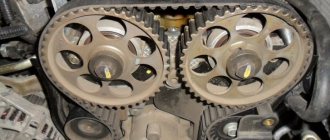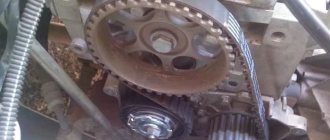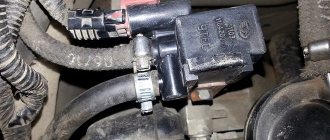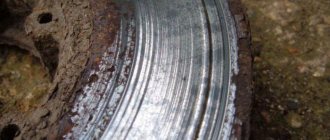Probably everyone who has encountered a 16-valve VAZ engine on a Priora knows about the problem of breakage. After which there will be expensive repairs - this is almost always the case, but there is a regulation according to which this unit must be changed after a certain mileage. The timing mechanism is a gas distribution mechanism responsible for operation by rotating the camshaft, intake and exhaust valves of the power unit.
In Priora cars with a VAZ 21126 engine (16 valves), there are 2 such shafts. The timing drive, together with the cooling system pump, is carried out by a toothed belt. The regulations for replacing the timing belt of a Priora car must be strictly observed. Unfortunately, 16 valves - of course, the dynamics of the Lada Priora car, but also the danger of a break. When a belt breaks, sad consequences arise (a bunch of bent valves, broken pistons, damage to the cylinder head). The technical regulations say about replacing the belt every 150,000 km. But experienced mechanics insist on replacing them every 50,000 - 60,000 km. due to non-compliance with the standard, with the actual service life and operating conditions. Replacing the timing belt of a Priora car can be done in a garage, with your own hands, although we must not forget about the marks on the pulleys. For one hundred, the price for replacing engine unit 126 (16 valves) is from 3,000 rubles. It is better to choose the gates brand for the timing belt itself - a set with 2 rollers is sold, its price starts from 5,000 rubles. There are cheap analogues for Priora, but you shouldn’t skimp! Read the article to the end and make sure that in a Priora car, it’s safer to do everything on time!
Timing belt on Priora 16 cl: its purpose
The timing drive part of the mechanism is made of high-quality materials. Provides synchronization of the operation of the intake and exhaust valves (16 pieces, two for intake and exhaust) with the engine operating strokes by transmitting the rotation of the crankshaft to the camshafts. At the same time, the belt drives the cooling system pump (pump). For improved adhesion to the surface of the pulleys, to avoid displacement along the camshaft marks on the inside, it has a toothed structure.
Standard belt - article number, price. Priora cars with engine 21126 are equipped at the factory with a LADA brand part, article No. 21126-1006040-00, 22mm wide. has 137 teeth, 22mm wide. Price is approximately from 1800 - 2200 rub.
About engines
The car was produced from 2007 to 2022, it replaced the VAZ 2110. The first Priors were equipped with engines from the previous model with some modifications, they had an index of 21116. There were 8 valves in the cylinder head, the timing drive was with a toothed belt. Experts note that this engine has good environmental performance, reduced operating noise, and increased power. The engine is of in-line type, the power system uses an injector. As a disadvantage, a decrease in the engine life compared to the indicators declared by the manufacturer was noted.
Engine 21126
After further modernization of the engine, version 21126 appeared, which is based on the previous cylinder block from the VAZ 21083, it received a twin-shaft cylinder head. The new Priora power unit with 16 valves has become a little more complex, but has received an increase in power and has become even more economical. The valve mechanism of this engine received a modified drive design; it was still belt driven. The length of the drive has become longer, so an automatic toothed belt tensioning system has been introduced. Somewhat later, the car was equipped with engines such as VAZ 21127, VAZ 21128, which were a modernized version of the VAZ 21126.
Are the valves bending?
Gasoline internal combustion engines of modern cars run on high-quality gasoline with an octane rating of 95 and higher. These types of fuel require a high compression ratio at the end of the piston stroke. Designers achieve this by reducing the combustion chamber in the cylinder head. This feature of the engine design carries the risk of damage to the valves, in some cases, pistons, and connecting rods in the engine. This can happen when the belt breaks or its teeth are cut off.
VAZ 21083 engines did not have such a problem since recesses for the valve heads were cast in the pistons. Therefore, their meeting with the pistons was not dangerous. On the engines of the new series, this was abandoned in order to increase efficiency, power, and other engine indicators. The designers believe that if the timing mechanism drive parts on the Priora are replaced in a timely manner, there will be no such problems. Every owner of a 16-valve Priora must remember that when the timing belt breaks, the valves are damaged. To the question of whether the valves on the 16 valve Priora are bent, the answer will only be in the affirmative, yes.
Replacing the timing belt: instructions
Let us note a slight difference in the procedure for replacing the belt on a Priora with and without air conditioning. You will need to first remove the belt and tensioner pulley of the generator (not to be confused with the timing tensioner) in order to dismantle the protective covers of the drive of the timing mechanism itself.
- Using a 15 mm socket, unscrew the tension roller of the generator, remove the belt itself (it is recommended to replace it together with the timing belt), access is open;
- Using a T-30 bit (asterisk), or a hexagon, unscrew 5 bolts of the upper cover (plastic casing) and 2 bolts of the lower timing drive cover;
- Disconnect the crankshaft sensor by disconnecting the corresponding chip located near the top cover;
- If it is necessary to replace the cooling system pump, you will have to lift the right drive wheel into the air with a jack. All this is needed to compare the marks of the camshaft pulleys with the marks on the block body;
- We rotate the raised wheel in 5th gear, or turn the crankshaft pulley with key number 17. Having matched the camshaft marks with the marks on the block body, it is necessary to turn on the neutral gear to avoid failure of the mark settings. Check the markings on the flywheel by removing the rubber plug at the top of the flywheel housing. Under the plug you can see part of the flywheel and the crown on it; align the flywheel mark with the triangular mark on the left side of the housing;
- If it is necessary to replace the pump, at this stage it is necessary to loosen the fastening of the 2 camshaft pulleys in order to avoid deformation of the valves when the gas distribution consumable is dismantled;
- To gain access to the crankshaft pulley, you need to turn the steering wheel as far as possible to the right or remove the wheel. You will need an assistant to remove the crankshaft pulley. Engage 5th gear, hold down the brake pedal, and use a 17mm key to unscrew the fastening bolt;
- ATTENTION! Left hand thread! Remove the pulley and thrust washer. Head 15mm;
- Unscrew the bolts securing the tension and thrust rollers, after dismantling which you can remove the timing belt. Install a new timing drive consumable. You need to apply tension by turning the tension roller with an offset center (the cutouts of the race and the tension roller bearing bushings must match). When reassembling, carefully monitor the marks on the camshaft pulleys and engine flywheel.
When replacing a part, the support and tension rollers are immediately changed - yes, the engine on the Priora is like that.
Signs of the need for internal combustion engine repair
The reasons why the operation of the engine is disrupted are arranged in a small list, starting with refusal to start and ending with floating idle speed (this problem was removed on the 127 “engine”). Not all breakdowns end in capital damage - sometimes it’s enough to add oil, sometimes it’s enough to adjust the ECU settings.
Compression reduction
A decrease in cylinder compression below 16 atmospheres is a bad sign. Such a high limit corresponds to a compression ratio of 11.
Knocks in the engine
Engine knocks can come from several points. These could be hydraulic compressors, timing belt rollers or pins. The knocking noise could also be caused by low oil level. The answer to the question will be given by a thorough detailed inspection of all parts of the unit and checking the oil level.
Blue smoke from the exhaust pipe
The blue smoke that comes from the exhaust pipe appears when oil enters the combustion chamber. It can leak either from the valves or from under the piston. The result is the same: the oil is eaten up and blue smoke pours out of the chimney. Once the leak is located, half the problem will already be solved.
Troit motor
Sometimes in the cold the engine may stall - don’t be alarmed by this, because it may simply be one of the spark plugs that fails. In this case, we advise you to simply restart the engine and it will stop running.
How much does it cost to overhaul a Priora engine - average price
Self-repair of a Priora engine with 16 valves costs an average of 16-20 thousand rubles. The cost depends on the severity of the breakdown and may be lower or higher than this average range. Repairing a Priora engine can be entrusted to the wrong hands, but then you will have to pay for the work - sometimes the cost of repairs reaches as much as 40 thousand rubles.
This is an unreasonably inflated figure, because, as practice shows, you can rebuild the engine on a Priora, working at a moderate pace, in just three days - and three days of work is definitely not worth that kind of money. Don’t be afraid of not being able to cope - your Lada is easy to repair, and using the advice and “tutorials”, you will conquer even such a task that is impossible at first glance.
Weak link: pump, roller, belt
The reasons for repairing the timing unit are most often broken bearings of the tensioner roller and pump, as well as the timing belt. The pump also has to be changed if the seal of the structure is lost, causing loss of coolant. To replace it, you will have to remove the camshaft pulleys and the rear protective cover of the casing. Remove the generator roller tensioner fasteners (3 bolts), unscrew the 6 bolts (10mm) securing the casing, two of which are located under the camshaft pulleys. After removing the casing, unscrew the 3 bolts securing the pump.
The marks on the pulleys must match
How to check tension
At the end of the work, it is necessary to adjust the tension of the timing belt drive on the Priora. The adjustment is made as follows:
- Using a special wrench, you need to turn the tensioner pulley counterclockwise.
Tensioner adjustment key
- Align the marks on the roller as shown above, and then tighten the fastening bolt.
- Rotate the crankshaft pulley 2 turns by the mounting bolt in a clockwise direction. At the same time, the coincidence of the marks on the camshaft and crankshaft pulleys is checked.
You can check the tension by applying force to a rubber product weighing 10 kg. The deviation value should not exceed 5-7 mm.
When tightening the pulley and roller bolts, it is recommended to use a torque wrench. The tightening torque for each element is equal to the following values:
- for the tension roller – 35-41 Nm;
- thrust roller – 105-110 Nm;
- pump mounting bolts – 15-20 Nm.
After adjustment, you can put the protective cover back in place. Finally, the generator belt tensioner roller is installed, as well as the belt itself. It is also recommended to replace these elements with new ones. Finally, do not forget to fill the coolant before starting the engine.
Upon completion of the work done, you can start the engine and check its operation. If the marks are correctly set, the engine will start the first time the key is turned in the ignition switch. In this case, the engine should operate evenly and keep the speed in the region of 800-900 rpm. Listen to the timing belt drive. There should be no extraneous sounds or noises. The presence of a whistle or hum indicates that the tensioner is too tight and needs to be loosened.
Video: replacing the timing belt and rollers with a pump on a Priora VAZ 2172, 2170, 2172 (timing marks)
In conclusion, it should be noted that the process of replacing the timing belt on a Lada Priora car does not present any difficulties if all steps are performed one by one. Even an inexperienced driver can handle this procedure, so don’t be afraid when the time comes to replace the belt product.
- Author: Andrey
Rate this article:
- 5
- 4
- 3
- 2
- 1
(28 votes, average: 4.2 out of 5)
Share with your friends!
Home →
Maintenance and Repair →
Engine →
When is it necessary to replace the timing belt on a Priora according to the regulations?
The mechanism requires constant attention to itself. The regulations for checking and replacing the timing belt of a Priora car with engine 21126 (16 valves) indicate regular condition checks every 10 - 15 thousand km. If you find any defects or damage to the structural integrity of the rubber part, replace it immediately.
Every 50 - 60 thousand mileage, it is necessary to change the spare part, regardless of its condition. Compliance with the regulations will help to avoid a number of extremely negative consequences that, in the most terrible scenarios, lead to almost a major overhaul of the car’s piston engine.
When to change: consequences of untimely change
It is recommended to replace the timing belt on a Priora after different periods of time. The manufacturer claims that it can withstand one hundred thousand mileage, but experience shows that a change may be needed much earlier.
The optimal period is every fifty thousand kilometers. Some argue that over such a short service life, rubber is simply not capable of failure. However, no one takes into account the conditions - roads, fuel quality, etc.
Also, during the operation of the mechanisms, it wears out, the rubber stretches, and therefore does not provide the correct tension of the timing belt, and slippage is possible. The teeth can wear off - because of this, traction with the gears is not ensured.
There is no exact time for a change that would suit all motorists. Some take good care of their vehicles, drive carefully, and use only high-quality fuel. Others use a more extreme type of driving, foreign liquids get on the rubber, etc.
In order not to lose your car during the repair period and not to spend a fortune on restoring the mechanics, write down or remember the date of the last timing belt change on the Priora. Next, regularly check the condition of the rubber; if worn, replace it with a new device.
Signs of possible failure
There are several characteristic signs that should alert the driver:
- When the engine is turned on, extraneous noise occurs. Sometimes drivers confuse a timing belt malfunction with a poorly functioning tension pulley.
- If the color of the exhaust gas has changed.
- The engine doesn't start well.
- An unusual vibration is felt.
Pay attention to these “symptoms”, even if the Priora’s mileage with a new timing belt has not yet reached 50 thousand km
It may fail earlier if foreign liquid gets onto the drive - oil, coolant, as well as dust or dirt.
It’s worse if it’s the coolant that gets onto the drive. Firstly, this means that the gasket that ensures the pump is sealed has failed, or there is a problem with the pump. Then the rubber is damaged and service life is reduced tenfold.
Even if the belt is new, but coolant or antifreeze gets on it, it will fail even after operating for 10 thousand miles. You will have to replace the Priora timing belt and figure out why foreign substances get on it.
How to check the serviceability of the belt yourself
If you suspect that it is time to replace the Priora timing belt, it would not hurt to check the serviceability of this rubber product. Visual diagnostics will allow you to check the serviceability and absence of scuffs on the Priora timing belt.
You should have a choice of one of the tools at hand, or two at once - a 5-point hex key, or a T-30 sprocket bit. If one doesn't work, try the second.
- Open and lift the hood.
- You will see the front panel covering the mechanism and timing belt.
- Take the key and unscrew the five bolts that hold the front panel, remove it.
- In front of you you will see a mechanism, including a tension roller.
- Place a jack on the passenger side and place the wheel in a suspended position. Engage fifth gear while it is working, look at the surface of the belt for damage, even small defects.
- If you notice cracks of any size, mechanical cuts, or threads sticking out, be sure to replace it by contacting a specialist or yourself.
- Check the pump. If any traces of coolant leakage from the pump are noticeable, then the rubber will also have to be changed, even if there is no mechanical damage.
- Check the tension roller. Auto mechanics advise changing it less often than tires. The average lifespan is approximately one hundred thousand kilometers. Change it every other time you change the belt.
- Measure the belt tension. To do this, press on the stretched rubber in the area between the gears of the two camshafts. You need to press with a force of about ten kilograms. Correct tension of the timing belt should not bend more than seven millimeters.
- Check that the rubber is not too loose. Make sure that the Priora timing marks match the original condition. The first, similar to a recess, is located on the outer race of the tension roller. The next one is located at the base of the roller. The maximum deviation is four millimeters; if the tension does not meet the standards, the product will have to be changed.
Found a discrepancy with the standards? Change the product. A belt set with rollers for the Priora 126 engine costs only five thousand rubles. This is a much smaller amount than the cost of a major repair if a component ruptures.
Checking the condition of the belt
The inspection regulations for this unit require an inspection in a cold engine state. Remove the outer protective casing to allow visual contact with the surface of the gas distribution unit parts. Having gained access directly to the timing belt, rotating its drive, inspect both sides of the consumable in detail for the presence of any kind of defects (wear, broken teeth, protruding cord, rubber delamination, etc.). Tensioner rollers are subject to careful inspection; in the presence of mechanical damage and large play, they contribute to increased wear of the consumables. The presence of oil stains on the surface of a rubber technical part, which contribute to the destruction of its structure, is not allowed. If found, immediately remove from surface.











